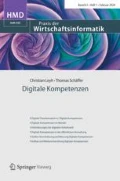Zusammenfassung
Zur Rechtfertigung von Maβnahmen für das Enterprise Content Management (ECM) ist die Darstellung des Erfolgs und der Performanz von ECM und ECM-Systemen notwendig. Nutzenpotenziale für ECM sind auf den Ebenen System, Prozess und Strategie identifizierbar und über Erfolgsfaktoren sowie entsprechende Leistungsindikatoren und Messgröβen messbar. Unterstützt wird die Argumentation durch die Darstellung eines einfachen Business Case und aufbauend auf einem anhand eines Praxisfalls entwickelten Modells für die Nutzerakzeptanz.
Literatur
Bals, C.; Smolnik, S.; Riempp, G.: Assessing User Acceptance of a Knowledge Management System in a Global Bank: Process Analysis and Concept Development. In: Sprague, R. (Hrsg.): Proceedings of the 40th Hawaii International Conference on System Sciences, IEEE Computer Society Press, Los Alamitos, CA, USA, 2007.
Büren, A.; Riempp, G.: State-of-the-Art des Content Management im deutschsprachigen Raum. In: IM — Information Management & Consulting, 17, 2, 2002, S. 81–88.
Christ, O.: Eine Architektur für das Content-Management — Strategien, Prozessmodelle, Softwarelösungen und Projektszenarien. Universität St. Gallen, St. Gallen, 2001.
Davis, F. D.: Perceived usefulness, perceived ease of use, and user acceptance of information technology. In: MIS Quarterly, Volume 13, Issue 3/September 1989, S. 319–339.
Donovan, T.: Wirtschaftliche Gründe für Content Management. Ein Leitfaden für Führungskräfte. Trend Consulting, London, 2001.
Jennex, M. E.; Olfman, L.: Assessing Knowledge Management Success. In: International Journal of Knowledge Management, 1(2), 2005, S. 33–49.
Karahanna, E.; Straub, D.; Chervany, N.: Information technology adoption across time — a cross-sectional comparison of pre-adoption and post-adoption beliefs. In: MIS Quarterly, Volume 23, Number 2/1999, S. 183–213.
Lewis, W.; Agarwal, R.; Sambamurthy, V.: Sources of Influence on Beliefs about Information Technology Use — An Empirical Study of Knowledge Workers. In: MIS Quarterly, Volume 27, Issue 4, December 2003, S. 657–678.
Reich, S.; Behrendt, W.: Technologien und Trends für Wissensarbeit und Wissensmanagement. In: HMD — Praxis der Wirtschaftsinformatik, 44. Jg., Heft 258, 2007, S. 6–15.
Riempp, G.: Integrierte Wissensmanagement-Systeme — Architektur und praktische Anwendung. Springer-Verlag, Berlin, 2004.
Author information
Authors and Affiliations
Corresponding author
Additional information
Für die inhaltliche Unterstützung dieses Beitrags möchte ich mich an dieser Stelle ganz herzlich bei Herrn Dipl.-Kfm. Michael Kaiser und Herrn Dipl.-Kfm. Cristof Bals bedanken.
Rights and permissions
About this article
Cite this article
Smolnik, S. Nutzenpotenziale und Performanzmessung. HMD 44, 25–34 (2007). https://doi.org/10.1007/BF03341135
Published:
Issue Date:
DOI: https://doi.org/10.1007/BF03341135

